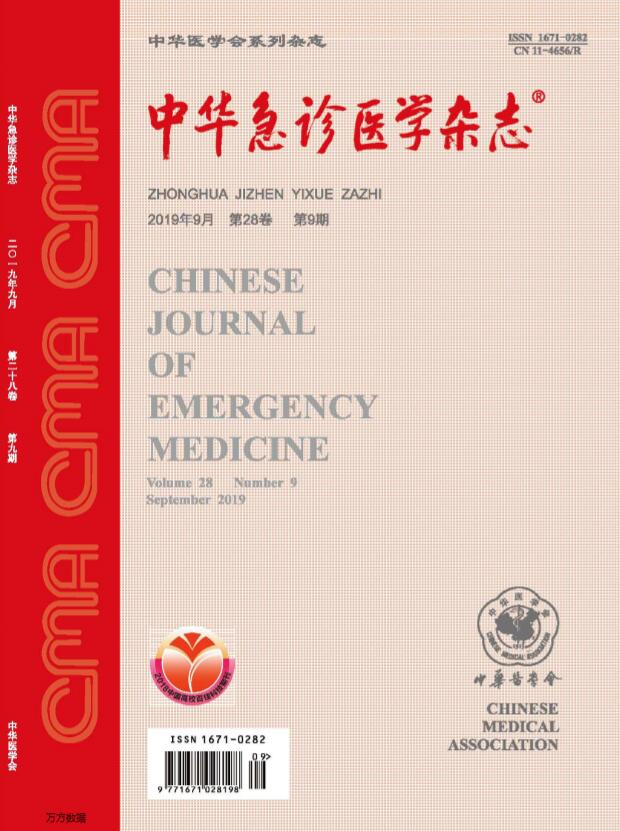不同通气方式对晚期气道置入术后心脏骤停患者通气率和预后的影响
Q4 Nursing
引用次数: 0
摘要
目的探讨不同通气方式对晚期气道置入术后心脏骤停患者通气率及预后的影响。方法根据国家紧急心脏骤停治疗数据库,对2013年12月至2018年6月在PUMCH急诊科接受心肺复苏术(CPR)中晚期气道置入术的患者进行统计。生理参数,如心电图波形、脉搏血氧仪体积描记波形和二氧化碳描记图,记录至少18分钟。收集人口统计学数据和复苏参数。波形脑电图用于计算通气率(VR),8至12次呼吸/分钟之间的VR被定义为合格通气率(QVR)。根据通气方式,将患者分为袋罩组(BMG)和机械通气组(MVG)。根据VR,机械通气组患者被分为两个亚组,VR大于20次呼吸/min的高频通气亚组(HFV亚组)和VR小于20次呼吸min的低频通气亚组。比较两组和亚组的VR、合格通气率(QVRR)、自主循环恢复率(ROSC)以及24小时和7天生存率。结果共有90例患者被纳入分析,其中袋式面罩组22例,机械通气组68例。ROSC总发生率为35.6%,24小时生存率为1.1%,7天生存率为0。收集前18分钟的通气数据,并将其相加至1620分钟。中位VR为16.5(12.0,26.0)次呼吸/分钟,QVRR为30%。与机械通气组相比,袋式面罩组的VR较低(10次呼吸/min vs 21次呼吸/min),QVRR较高(88.9%vs 11.5%)。两组的ROSC、24小时生存率和7天生存率无统计学差异。在机械通气组中,VR超过20次呼吸/分钟的比率为52.6%。在两个亚组之间,ROSC、24小时生存率和7天生存率没有统计学差异。结论与机械通气相比,袋式面罩通气的VR较低,QVRR较高。但结果没有统计学差异。两个机械通气亚组的结果没有差异。关键词:心脏骤停;心肺复苏;机械通风;通风量;袋式面罩通风本文章由计算机程序翻译,如有差异,请以英文原文为准。
The effect of different ventilation modes on the ventilation rate and prognosis in patients with cardiac arrest after advanced airway placement
Objective
To investigate the effect of different ventilation modes on the ventilation rate and prognosis in patients with cardiac arrest after advanced airway placement.
Methods
Based on the national database of emergency cardiac arrest treatment, patients treated with advanced airway placement during cardiopulmonary resuscitation (CPR) were enrolled in PUMCH Emergency Department from December 2013 to June 2018. The physiological parameters, such as electrocardiograph waveform, pulse oximetry plethysmographic waveform and capnography, were recorded at least 18 minutes. The demographic data and resuscitation parameters were collected. Waveform capnography was used for calculating ventilation rate (VR) and the VR between 8 to 12 breaths/min was defined as the qualified ventilation rate (QVR). According to the ventilation modes, patients were divided into the bag-mask group (BMG) and mechanical ventilation group (MVG). According to the VR, patients in the mechanical ventilation group were divided into two subgroups, the high-frequency ventilation subgroup (HFV subgroup) with the VR more than 20 breaths/min and the low-frequency VR subgroup (LFV subgroup) with the VR less than 20 breaths/min. VR, the qualified ventilation rate ratio (QVRR), the return of spontaneous circulation (ROSC), and 24-h and 7-day survival were compared between the two groups and subgroups.
Result
A total of 90 patients were enrolled in the analysis with 22 patients in the bag-mask group and 68 patients in the mechanical ventilation group. The total rate of ROSC was 35.6%, 24-h survival was 1.1% and 7-day survival was 0. The first 18 minutes ventilation data were collected and added up to 1 620 min. The median VR was 16.5 (12.0, 26.0) breaths/min and the QVRR was 30%. Compared with the mechanical ventilation group, the VR in the bag-mask group were lower (10 breaths/min vs 21 breaths/min) and the QVRR was higher (88.9% vs 11.5%). The ROSC, 24-h survival and 7-day survival had no statistical differences between the two groups. In the mechanical ventilation group, the ratio of VR more than 20 breaths/min was 52.6%. Between the two subgroups, there was no statistical difference in ROSC, 24-h survival and 7-day survival.
Conclusions
Compared with the mechanical ventilation during CPR, the VR is lower with bag-mask ventilation, and the QVRR is higher. But there was no statistical difference on the outcomes. There was no difference on the outcomes between the two mechanical ventilation subgroups.
Key words:
Cardiac arrest; Cardiopulmonary resuscitation; Mechanical ventilation; Ventilation rate; Bag-mask ventilation
求助全文
通过发布文献求助,成功后即可免费获取论文全文。
去求助
来源期刊

中华急诊医学杂志
Nursing-Emergency Nursing
CiteScore
0.10
自引率
0.00%
发文量
8629
期刊介绍:
Chinese Journal of Emergency Medicine is the only national journal which represents the development of emergency medicine in China. The journal is supervised by China Association of Science and Technology, sponsored by Chinese Medical Association, and co-sponsored by Zhejiang University. The journal publishes original research articles dealing with all aspects of clinical practice and research in emergency medicine. The columns include Pre-Hospital Rescue, Emergency Care, Trauma, Resuscitation, Poisoning, Disaster Medicine, Continuing Education, etc. It has a wide coverage in China, and builds up communication with Hong Kong, Macao, Taiwan and international emergency medicine circles.
 求助内容:
求助内容: 应助结果提醒方式:
应助结果提醒方式:


